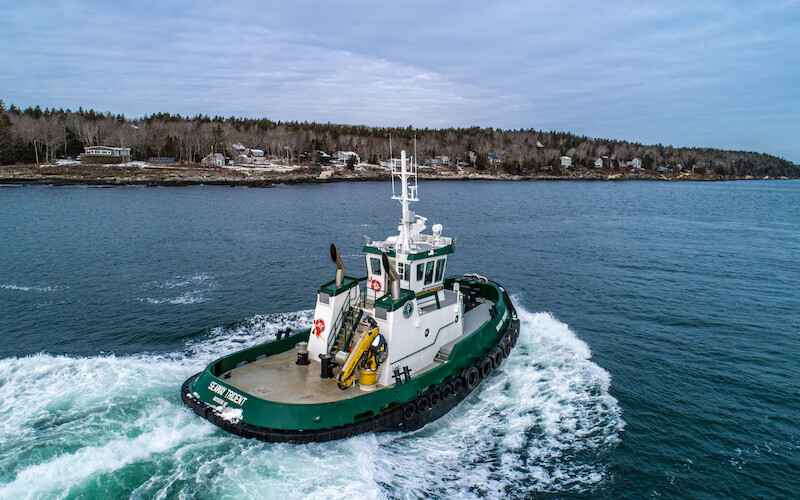The term “tugboat” doesn’t come close to describing the 60'x28'x10'6" Seaway Trident. It looks like a tugboat. Maritime publications label it a tugboat. Its designer refers to it as a tugboat. But the primary focus is not maneuvering vessels in or out of a crowded harbor. Try scraping ice off the walls of locks, maintaining aids to navigation and, well, yes, moving various barges about.
The Seaway Trident, powered by a pair of 660-hp Caterpillar C-18s turning Schottel SRP 210 Z-drives, was designed by Glosten, with offices in Seattle, Wash., and Providence, R.I. and built by Washburn & Doughty in East Boothbay, Maine, for the Great Lakes St. Lawrence Seaway Development Corp., an agency of the U. S. Department of Transportation.
As the company name implies, the Seaway Trident works along the St. Lawrence Seaway.
“Primarily it’s stationed between the Snell Lock and the Eisenhower Lock,” (That’s a narrow part of the St. Lawrence Seaway on the U.S. side.) said Peter Soles who works in marine operations and business development at Glosten’s Seattle office. “They call it the pond. I think it ices up pretty hard.”
The Seaway Trident’s major role is keeping the St. Lawrence Seaway navigable by maintaining the locks and the aids to navigation, which requires a lot of winter ice work. For that the Seaway Trident often will join with the larger Seaway Guardian (118'x17.5'). The Seaway Guardian breaks up ice jams, while the Seaway Trident pushes the ice to the side of the channel, thus keeping the passage clear. It also herds ice into a lock chamber, allowing the ice to flow down river.
The Seaway Trident is the right size for another major winter job, maneuvering inside a lock chamber to scrape ice off lock walls. Prior to the Seaway Trident, a tug with an ice scraper mounted on the bow would push along the lock wall, clearing the ice as best it could. That meant having to hold an angle to the wall while moving through the lock. But the Seaway Trident, being Z-drive powered, “We felt we could do the ice scraping in a much more controlled way,” said Soles. Thus a scraper blade was installed “on the side of the boat adjacent to the drive unit, so it can hold the boat against the lock wall and kind of slide down and grind the ice off.”
Having to deal with winter’s ice is why the Seaway Trident was designed as a variant of Glosten’s HT-60 model, the smallest of Glosten’s Harbor Series tugs. The “variant” part of the deal was building the hull to ABS Ice Class CO standards. That required “one-foot frame spacing in the bow and thicker plating all around,” said Soles, adding that “we went beyond ABS CO standards and put one-foot frame spacing in the stern,” which is framed longitudinally, and added thicker plating all-around. Most of the hull plating is ½", including the entire bow region, with some 3/8" bottom plating in aft hull sections and ¾" guard plating. “It’s strengthened at both ends, so all options are on the table,” noted Soles.
Ice protection includes the two Schottel Z-drives. They “are not the standard model,” Soles pointed out. “They are custom built and ice strengthened to meet Finnish-Swedish IC (Ice Class) standards,” which requires a much harder casing.
Yet all is not ice and winter work. In the spring, the Seaway Trident resets floating navigation aids that were removed prior to winter, which also extends its operating range to Lake Ontario, for about a 150-mile operating radius. In this chore, Soles describes the Seaway Trident as being “nimble,” since the navigation aids “need to be positioned precisely where they need to go and hold station while it’s doing that.”
The Seaway Trident also works with the Seaway Guardian to move buoy barges, derrick barges and periodically pulls the lock gates for maintenance work. On deck a Heila HLMR fully foldable deck crane and a Markey DESMG-18 headline winch can be utilized when needed.
Soles said the Seaway Trident as primarily a day boat that only needs a crew of two but can accommodate four “pretty comfortably” in two staterooms down below. There’s a galley and settee and “mahogany finish work throughout the boat.”
Reflecting on the Seaway Trident’s experience, Soles said, “It’s a pretty interesting work profile, different from what most tugs do.”





